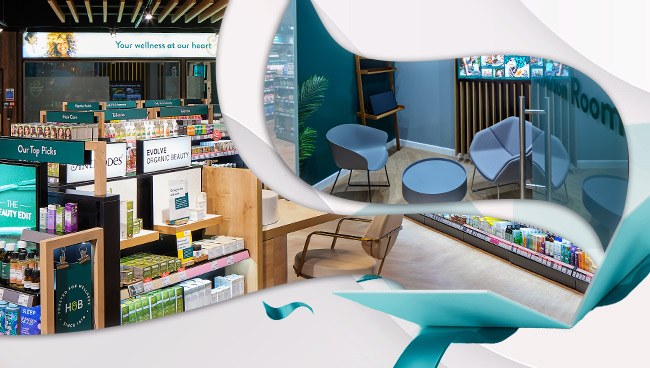Retail pharmacy is facing a massive challenge. They are expected to provide relevant, hands-on and technology-based solutions for their customers. Yet a surge in vaccine and self-care demands has caused more shoppers to crowd the pharmacy counter. The resulting wait, paired with the ease of finding wellness answers online, is raising the bar – and opportunities – our research shows.
A Pharmacy Is a Magic Box – If It Keeps Up With Expectations
For generations, retail pharmacies served as a healthcare “magic box” for customers, patients and caregivers. A one-stop place for reliable advice, delivered in a hands-on manner, without an appointment.
Since the pandemic, that magic has bewitched pharmacies and the retailers that house them.
Today, pharmacists are overwhelmed by demand for vaccines, understaffed, filling prescriptions and consultations. The shortage of pharmacists compounds the problem for retailers. In the first nine months of 2023, nearly 61,000 pharmacy openings were posted, half by retail stores. And enrollment in pharmacy programs continues to decline.
Pharmacy customers are more informed than ever, meaning their expectations are higher, thanks to the self-care trend and Google. It is no longer a short conversation asking the pharmacist’s input, it is more complex.
As explained to us recently by Alex Gourlay, former president of Walgreens and executive chair of the wellness retailer Holland & Barrett in the U.K.:
“They’ll come in as really quite knowledgeable, sometimes very knowledgeable. And our job in our new magic box is to make sure that we can add value to their knowledge.“
Following The New Shopper Journey to Wellness
Adding value takes work (and patience) when customers have so many options for health information. So we followed the shopper’s path to identify new pharmacy opportunities. Here’s what pharmacies should know, according to our How America Shops® report, “The New Journey to Wellness“:
- Search engines win as a wellness resource. At least 50% of men and women turn to Google to begin their search for health information for a range of conditions, including arthritis, diabetes, menopause, gut health, sexual health, brain health and reinforcing immunity.
- In-store pharmacists lag as an information go-to. In these same health categories, no more than 20% of men or women turned to their in-store pharmacists first, not because pharmacists are not knowledgeable, but because the line for consultation is often too long and a private conversation is not realistic.
- However, when combined with visits to an online pharmacist, the figure scales up. And interestingly, men are more likely to rely on in-store and online pharmacists than women, with their highest reliance for a health topic exceeding 30% for men. For women, the figure tops out at 20%.
- The sensitivity of the topic determines the path for information. 27% of men look for guidance on erectile dysfunction[1], but 25% consulted their in-store pharmacist. One in four women search for relief from incontinence, but only 6% asked an in-store pharmacist.
These journeys follow a surprising finding from our 2022 WELLness research: That while 91% of shoppers used a pharmacist at least once a year, just 57% said they trusted them… but here’s the thing: We don’t think the issue is a lack of trust in pharmacists. We suspect it’s simply a desire for actually consulting with the pharmacist in a more efficient process.
5 Tips for Expanding the Pharmacy’s Role in Retail
As pointed out by Alex Gourlay in our Future Shop podcast, “Building a ‘Magic’ Health Care Box,” retail pharmacists have many opportunities to play an integral role in the shopper’s wellness journey. Here are a five ways, based on our shopper insights.
- Redefine the pharmacist’s role. By analyzing the wellness-specific data of their patients, pharmacists can be helpful as in-store experts and can assess how to guide them. Purposeful hands-on expertise should transform more shopper queries into product purchases and return visits. Of course, this takes time and pharmacists have little time for consultation. A first step is to rethink how to give pharmacists more time for patient care.
- Give the customer privacy. As our research confirms, consumers with sensitive health issues are less likely to see a pharmacist in person for fear of the conversation being overheard. Separate consultation spaces or scheduled online consultations would ensure discretion.
- Join the telehealth movement. The pandemic introduced many people to the convenience of telehealth consultations, and when something becomes easier there is no going back. In our 2022 How America Shops® wellness report, almost half of Gen Z and Millennials said they had used telehealth in the previous three months, followed by 29% of Gen X and almost one in five of Boomers. Retailer-sponsored telehealth consultations can relieve pressure in the store and offer trained pharmacists flexible hours.
- Bridge the gap to understanding women. Women are less likely than men to seek a pharmacist for advice. Is it the wait? The lack of privacy? Both? Losing women at the pharmacy means retailers risk losing significant spending opportunities. Displays that show the pharmacy not only carries a range of solutions for female health issues, but also can provide personalized expertise, will help restore rapport.
- Make the wait a healthier one. When customers wait to pick up a prescription or see the pharmacist, what merchandise surrounds them? Bags of sugary or fatty snacks are out of sync with the healthy temptation that should be offered shoppers waiting for a prescription pickup or vaccine. How about more impulse items like personal care, beauty, Band-Aids? Care is in order to make sure pharmacy customers are surrounded by products that will make them feel healthier.
Retail’s Holistic Journey to Wellness Is Paved with Research
The shopper’s path to wellness is guided by many factors outside their health conditions. Easy, affordable and knowledge-based guidance can de-stress shoppers about symptoms – and support the image of retailers as health care providers. Visit our Shopper Research page today.


